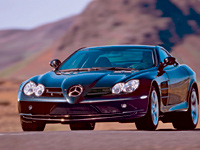|

Daring or Nostalgic?
Aa Car’s
Shade Reflects Deeper Meanings
By
Stephen Drucker
At one time it seemed funny that Henry Ford offered his Model T “in any color, as long as it’s black.” It doesn’t seem funny now. If you are currently considering a Mercedes-Benz S-Class, you have five blacks to choose from. If the Bentley Arnage is your preference, you have six. The HUMMER H1 comes in nine ferocious colors, three of them black.
Car designers are constantly rearranging the rainbow, knowing color can help a car be more of what it means to be. “It’s not all about driving,” said Verena Kloos, president of the BMW Group’s Designworks USA. “You leave your house. You see your car. You have…expectations.” Fashion wields little influence in this world. Car colors follow longer, more mysterious cycles, with rules of their own. A good one to know is, the more “emotional” the car, the more color it can handle.
 |
Mercedes-Benz SLR McLaren, crystal galaxite black |
There isn’t much color on the road right now. Silver, black, white and beige account for more than half the new cars in this country. Silver outsells everything. Last year nearly 24 percent of new cars were silver, according to the Power Information Network. It suits our technology-obsessed time: Like a stainless-steel stove, a silver car suggests a serious machine. If our era hasn’t produced many brown cars, it’s because brown doesn’t send the message “high performance.”
Almost 17 percent of new cars are black. The color of the minister’s sedan turned sexy quite suddenly in the 1980s, when the matte-black Sony Trinitron and Braun appliance ascended. “It’s the car enthusiast’s color,” says Christopher Webb, creative designer, color and trim, at General Motors. Mercedes-Benz, which sells 30 percent of some models in it, has developed a spectrum of blacks with undertones of color. “Customers want to express their choice of black,” says Patrik Borenius, department manager, advanced product planning, at Mercedes.
Europeans shun white, but Americans, especially in the Sunbelt, like it. The Japanese associate white with luxury, so when Lexus was launched in the United States in 1989, it also launched pearl white, in a calculated message to buyers. Nearly 30 percent of them ordered it. Today Lexus has a rainbow of pearl whites.
These new blacks and whites and in-betweens have been made possible by new paint finishes, which aim less for one solid color and more for layered effects. By varying the reflective flakes in metallic and pearl finishes, designers can make cars more sparkly, velvety, sculptural, machinelike, luxurious or aggressive. The future of color is effects. “Tinted silvers” — not quite silver but less insistent than color — are already proliferating. In Europe, Mercedes is building 100 matte-metallic Giorgio Armani editions of its CLK Cabriolet and will soon offer a high-gloss metallic skin in steel and sterling shades. Until recently the most ambitious finish in production had three coats; Lexus now offers a prismatic four-coat finish in chardonnay pearl or mercury metallic.
Pure color won’t be going away, however. Its historic purpose was distinguishing the nationalities of race cars: Italian cars were red; French cars were blue; English cars were green; and Germany adopted silver, the story goes, because removing the paint produced a faster car. This racing tradition is still in car DNA. Those who dream of Ferraris tend to dream in red. Mercedes offers its SLR McLaren roadster only in silver or black. Mini Cooper cultivated a storm-the-Corniches rally image by including all the racing colors in its palette. And at a time when most nameplates offer one green, if any, Jaguar offers two British racing greens. “There’s a curious reverse psychology, though,” says David Goggins, director of marketing and communications at Bentley Motors, Inc. “It’s often the export market that favors the classic. In England a British racing green car with a tan leather interior would be considered a bit twee, a bit obvious.”
Lately, blue is ticking upward, which always means green is losing steam, and red has its usual steady following. But, says Christine Dickey, color and trim manager, Toyota Motor Sales, USA, “if a car is all excitement, it can exhaust a person.” Yellow has been the great experiment of late. Mercedes tried it on the sporty SLK, but “the psyche of the brand did not lend itself to yellow,” says Bernhard Glaser, general manager, product management, passenger cars. Yet HUMMER found a soulmate in the color. “Yellow is really in your face,” says Jay Ostahowski, HUMMER brand character manager. “It sells only in the single digits, but it’s the color most associated with HUMMER.”
The most daring colors appear on new models, where, Dickey says, “there are no preexisting notions of what color the car ought to be.” The Nissan Murano, Infiniti FX, Honda Element and Dodge Magnum were all received warmly in some highly improbable copper-orange reds. Volkswagen enhanced the aura of its New Beetle Convertible with a nostalgic flower-power palette. Aquarius blue, a psychological match of color to car worthy of Jung, is the best seller for the model in the United States. Color also helped shape the identity of the Scion xB, Toyota’s haunting Box That Fell to Earth. Cars for the young usually come in high spirited colors, but, Dickey explains, “youth and bright is a stereotype.” The xB comes mostly in dark pearl finishes with the appropriate snarl.
Now imagine you can have any color. Aston Martin offers 20 in its stock palette. Or you can request any color ever available on any production car. Or, for a surcharge, the company will formulate a paint to match any sample you provide. Anything is possible.
Last year the most popular Aston Martin color was silver.
(Reprinted with permission from Architectural Digest, July 2005) |